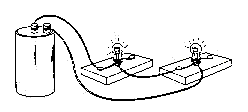BACKGROUND:
 A simple series
circuit is shown in the figure on the right. When connected in a series,
a single pathway is formed through which current flows. A parallel
circuit (figure in the procedure), form branches, each of which is a
separate path for the flow of electrons. Both series and parallel
connection have their own distinctive characteristics. A simple series
circuit is shown in the figure on the right. When connected in a series,
a single pathway is formed through which current flows. A parallel
circuit (figure in the procedure), form branches, each of which is a
separate path for the flow of electrons. Both series and parallel
connection have their own distinctive characteristics.
In a series circuit, when one of the
bulbs or one of the wires is left open or is broken, the entire circuit
ceases. The break opens the circuit. Less expensive Christmas lights are
usually of this type, and you have to search for the defective bulb. A
parallel circuit is designed so that if one branch is defective, the
flow of electricity will not be broken to the other branches.
PROCEDURE:
-
Give each group an
Energy. (Do not take the Energy Ball apart unless you are
replacing the batteries inside.) Show students that by putting two
fingers on the electrodes, (pieces of metal) the "energy ball"
speaks. The circuit has been completed. As you add another student one
holds the energy ball will continue to work. The students are
acting as a "wire" and they are completing the circuit. arranged
similar to the two above figures. They are creating a series circuit as
the entire class holds hands. Instruct different students to
"break" the circuit, which just means they do not hold
hands.
If you have a class of 30, you may want to break them up into
groups. Each group gets an energy ball. As they successfully
create a series circuit in small groups, have then merge the groups
until the entire class is holding hands. Always ask the
question, "Is there a limit on the number of
people?" We have done up to 200 people and it still works!
The energy ball has two watch batteries inside, a computer
chip, a small light, and a sound system. These will last for up to 3 or
4 years, depending on the batteries. The ball can be opened along its
equators to replace the batteries.
-
The lab is
designed for students to work in groups of 4 or 5 and to make their own
parallel and series circuit. If you have enough equipment, have two
students work with 1 "Circuit Set Up", 1 battery holder, and 2 D
batteries.. Have them make a series
circuit. Then have four students put together a series circuit and
continue until the entire class has made a series circuit.
This is sometimes difficult because the students have to "wire"
the circuit. Some common problems are: (1) bulb is
loose; (2) connection is not tight; (3) battery is not strong
enough (sometimes you need to subtract a bulb to make it work); and (4)
students cross the wires. Keep working on it until it
works. You may want to remind them, that electricians are
important in keeping the electricity running in our city.
-
After the series
circuit, have about 4 sets (about 8 children) work to put the parallel
circuit together. Students will only have to use one battery holder with
2 batteries. They should also realize that they can hook up two
alligator clips at each electrode on the lamp holder like below.

-
During the conclusion,
ask students which circuit would be better for use in the home. Hopefully
they will see that a parallel circuit has many more advantages. In a
series circuit, the greater the number of lamps, the more the lamps will
dim. Energy is divided among more lamps so the voltage drops across each
lamp. In the parallel circuit, all lamps get the same voltage, so all are
the same brightness.
Students might ask questions about why lights
suddenly go out at home. This is usually caused when lines carry more than
a safe amount and "overload". To prevent overloading in
circuits, fuses are connected in series along the supply line. In this way
the entire line current flows through the fuse. A fuse is constructed with
a ribbon of wires with a low melting point. If the current in the line
becomes dangerously large, both lines in a fuse become hot and the fuse
"blows out." Circuits may also be protected by circuit breakers
which use magnets or bimetallic strips to open the switch when overloaded.
-
Note that in a series
circuit, the brightness of the light decreases. Warn students not to put
too much voltage. If you only have a 1.5 volt battery, you can only light
a 1.5 volt light bulb. If you have a light bulb that requires 120 volts,
your battery will not allow it. If you have a 6 volt battery and a 1.5
volt light bulb, you will "blow" the bulb.
|